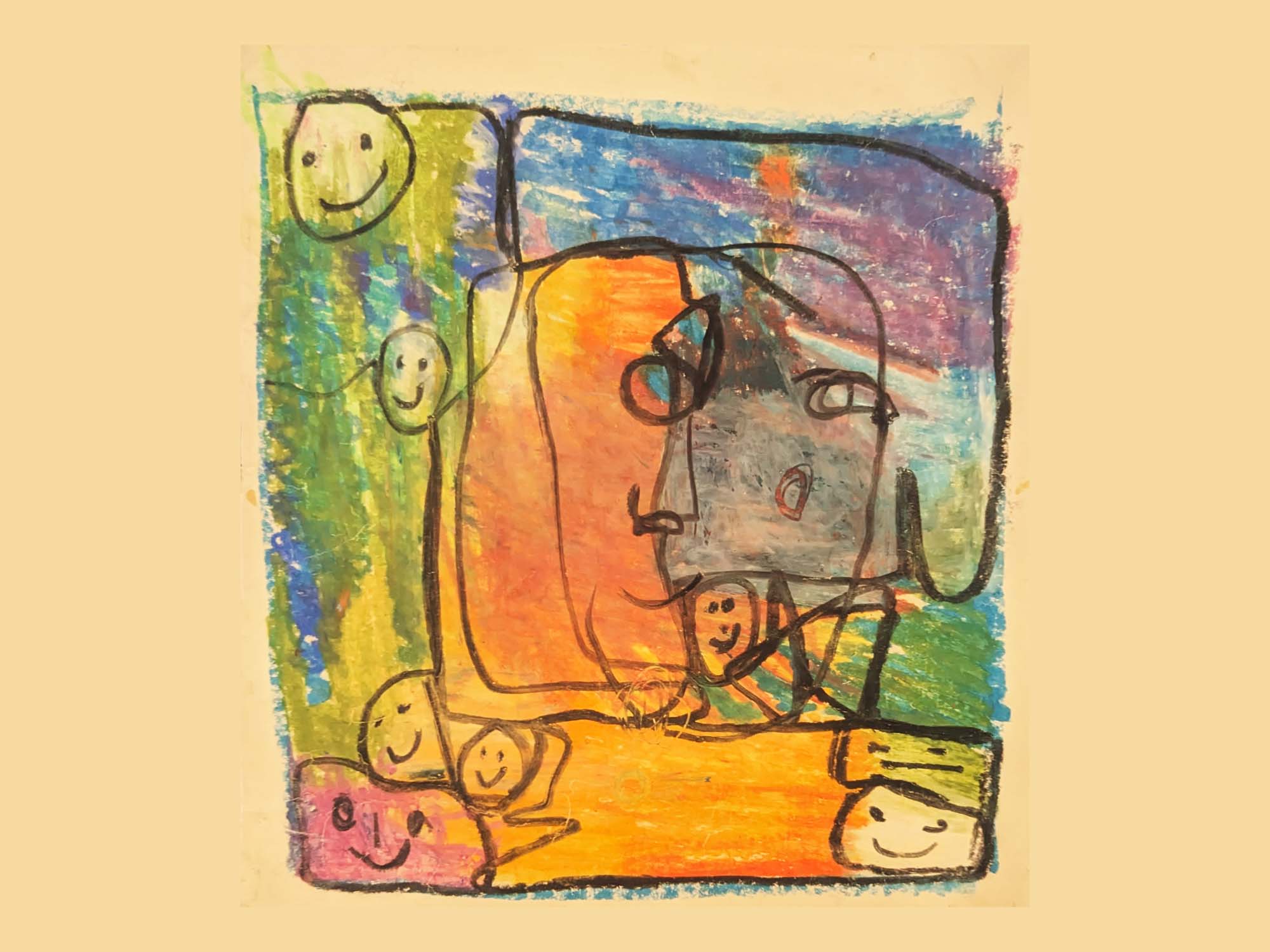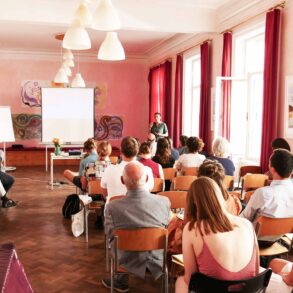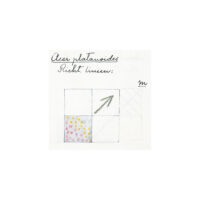An exhibition of early childhood drawings opens up insight into the universal imagery and development of children in the first seven years. The exhibition in a mill near Weimar, which continues until June 25, shows expressive drawings by children from around the world.
There probably aren’t any children in the world who don’t draw. Some may draw less, others more. When my daughter was in kindergarten she would get up in the morning and draw a picture — first thing. She would sometimes produce the most striking, immensely powerful drawings at the break of dawn, revealing her intuitive form language, sense of color harmony and heart’s message. My daughter drew excessively, devotedly, often in series. I still have an inner picture of some of her drawings. One of her most beautiful works was done when she was about four. It still has pride of place on her grandma’s piano: two radiant suns next to each other in a web of symmetrical lines with a delicate little tree, probably a birch, in between, drawn on deep red watercolor paper and poetically adorned with a snippet of gold ribbon. What is the meaning of these two mysterious suns? I carried this question with me for a long time. Norbert Carstens’ Child Art exhibition has unlocked this secret for me.
Norbert Carstens began to explore the magic of children’s drawings as a young man. His quest was inspired by the question of whether a common developmental dynamic may be concealed behind early childhood pictures. For more than 40 years he looked for common and universal elements in children’s drawings from around the world. Norbert Carstens, an art teacher and eurythmist, collected numerous drawings from different nurseries and institutions, some in therapeutic contexts; even entire legacies were given to him. He studied children’s drawings and paintings intensively, both in the modern art world and in a wider research context and even examined baby food smears.
As well as displaying children’s drawings from the past hundred years, the Child Art exhibition gives access to methodological thoughts and observations of artists including Paul Klee, Wassily Kandinsky, Erich Kästner, Arno Stern and Antoine de Saint-Exupéry. What these artists have in common is a deep reverence for the wonder of children’s drawings that are beyond evaluation or even interference. “For these are first artistic beginnings, such as one usually finds in ethnographic studies or at home in one’s nursery. Do not laugh, reader! Children have artistic ability and there is wisdom in their having it! The more helpless they are, the more instructive are the examples they provide for us; and they must be kept free of corruption from early on” (Paul Klee). Some pictures in this exhibition go back to a time when children’s drawings were seen as “visual pollution.” The increase in society of appreciation for children’s paintings is due to the work of Paul Klee and Wassily Kandinsky. As lecturers and artists of the Weimar Bauhaus movement they intensely studied the expressiveness of children’s creative processes and arranged exhibitions to make them accessible to the public.
Free Drawing
The Child Art exhibition seeks to follow the Bauhaus spirit and call society’s awareness again to the drawing of children. For even now, a hundred years later, the children’s agency is under threat. Even the very youngest are faced with early intervention, cognitivism, and ideas from the adult world such as coloring-in books and instructions for drawing. Elephants are grey. Really? When children draw, elephants can be any color. Children need free drawing as much as they need free play. Drawing is also play. Norbert Carstens wants children to have this freedom. Respecting their natural development and their unfolding of creative forces are the central motifs in his exhibition. All the pictures shown were drawn freely.
The exhibition is arranged in a way that impressively reflects the development of childhood drawings. Children start by drawing loops and spirals that later turn into circles and tadpole people, consisting of a head and legs only. At the age of around six, they like to draw a person in a house. The house motif appears precisely at the age when the child’s life body has come to maturation. Norbert Carstens explains that “Nature does not need to be taught. Every picture is an original process leaving its traces.” The child’s personal and physical development become visible in a drawing process that is both individual and universal.

Visitors of the exhibition can follow this development from the early straight and curved lines to basic forms such as squares, triangles and circles in the early years. Under their own direction children develop the ability to draw the building blocks that make up our world. Again, this is evidence of the wisdom innate in children. Johannes Kepler said as early as 500 years ago that “the total essence of the world is encompassed in the contrasts of the straight and rounded line.” Children are not aware of this law, but it is evident in their drawings.
Intuitive Truth
What else finds expression in children’s drawings? Intuitive truth and profound wisdom and certainly immediacy. One can see directly into the child soul. Children’s drawings have an intuitive aesthetic, an originality that the artist Paul Klee yearned for at the end of his active life. This yearning is understandable when one looks at the many exhibits in the Child Art exhibition, which are all simply great works of art, by very young people. An open mind will find works of art in every child’s room, such as my daughter’s picture of the two adjacent suns. What about its secret? Norbert Carstens explains that at the age of around three or four years, children tend to draw two suns next to each other. When we follow the further development of their drawing, we find something that speaks of the human soul’s pre-earthly existence. While one sun remains high up in the sky, the other makes its way down to the earth where it turns into a tadpole person and then the earthly child. In their drawings of two suns, children whisper to us their secret of the journey through the heavenly world to earthly life.
After visiting this exhibition in a mill near Weimar one will certainly look at children’s drawings with different eyes. The venue itself is worth a visit, too. A place for childhood romantics, where chickens and goats roam the garden, children play, and a peacock on the roof calls people to the exhibition. It is a young place, a rural idyll, where everything is evolving. The mill is home to an initiative called SINNsorium which seeks to change the face of the world in small and meaningful ways in collaboration with other projects and organizations (including the World Child Forum reported on in Das Goetheanum). The SINNsorium sees itself as a space of potential and development, a place for children, for the future and for life. Activities here are inspired by the motto that we have to preserve the space for the children but that we need the children to help us (Bernhard Hanel, World Child Forum founder). Weimar is the city of Goethe, a place where classicism, Bauhaus, and reminders of Nazi Germany come together. Now it invites its visitors to the Child Art exhibition on the Ettersberg hill. The exhibition venue is located a few minutes from the Buchenwald Memorial. In the fall, the exhibition will travel on to Bochum (GE) via the World Child Forum in Davos (SW).
More SINNsorium, Child Art
Translation Margot M. Saar
Artwork from the exhibition













